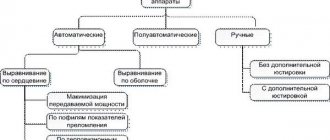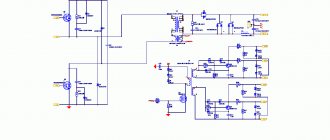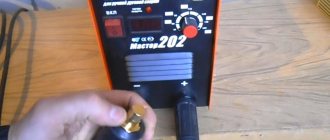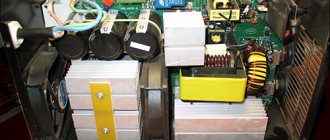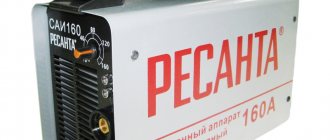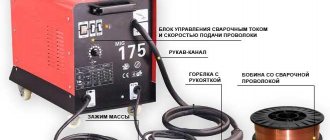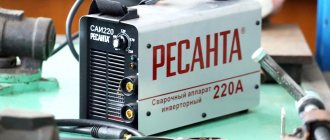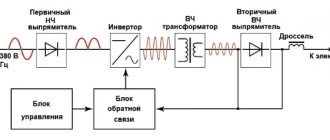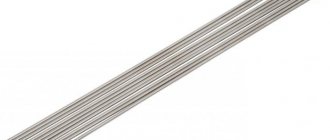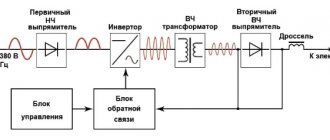Welding machine + Starter-charger (3in1) AIRLINE AJS-W-03. Photo 220Volt
A reliable welding machine with a charger is useful in everyday life; it is intended for both professionals and amateurs. At the same time, it has the characteristics of a device for starting a car and recharging the battery. It has microprocessors to control the technical characteristics of the arc and can be used in work where semi-automatic welding (MIG/MAG) is required. The kit may include a device for wire feeding. The welding machine with a charger is easy to use and economical in energy consumption.
*
Universal device: what is it?
Whatever they call it: universal inverter, 3-in-1 welding machine, 4-in-1 universal welding machine and many more names. But the essence is the same: a universal machine combines several welding functions, and therefore can replace several welding machines.
The 3-in-1 machine can perform three types of welding or two types of welding + cutting. A typical 3-in-1 machine may combine MMA, TIG and MIG/MAG welding, or MMA, TIG and CUT (cutting). 4-in-1 devices are much less common and allow you to perform all main types of welding (MMA, TIG, MIG/MAG) + cutting (CUT).
Let us explain the meaning of these abbreviations if you are a beginner. MMA is manual arc welding with a consumable electrode. TIG is welding with a non-consumable electrode in an argon environment. And MIG/MAG is welding with a consumable filler wire in a protective gas environment.
It’s not for nothing that this universal device is named so. It can actually replace multiple inverters. After all, manufacturers often produce devices capable of performing one or at most two types of welding. Universal inverters do not have this drawback and can become a full-fledged assistant in the household. But you must take into account that with such great functionality, the price tag for a universal device will be twice as high as that of a regular MMA inverter or semi-automatic device.
Also keep in mind that TIG and MIG/MAG welding are not the most economical technologies for amateur welding. When doing MMA welding, you can buy a pack of electrodes and forget about spending. But with TIG and MIG/MAG welding, you will have to additionally buy gas cylinders, hoses, filler wire and non-consumable electrodes. In large-scale production, these expenses quickly pay for themselves, but when welding in the country, this is almost always an additional waste of money.
Make sure it makes sense for you to have all of these welding technologies in your welding machine. If you assemble a greenhouse or cook a gate a couple of times a year, then it is better to purchase a regular inexpensive inverter and electrodes. A universal device is necessary either for professionals or practicing craftsmen who need such equipment.
Household inverters and battery charging
How to charge a car with a welding machine can be seen in the video.
But if you have a special device, then you don’t have to risk burning anything.
Do-it-yourself starter-charger from a welder - is it worth it?
To bring this idea to life, you need not only a special tool and the ability to use it, but also the knowledge to correctly calculate electrical circuits.
Let's start with the starting device . It is usually required in winter, when the battery is dead and the engine is frozen. In cars of older designs, a ratchet was screwed into the front end of the crankshaft for a “crooked starter”. Motorists of the older generation remember how difficult it was to turn it in the “icy winter season” (young people will have to believe it). An electric starter, in order to create the appropriate torque, needs a very high direct current at a relatively low voltage (10...12 volts on carburetor engines and 20...24 volts on diesel engines).
Welding transformers do not have a secondary winding that creates such voltage, and there is no room in the “window” for winding a new one. Any “combination” with lowering the voltage of the primary winding (an additional step-down transformer or autotransformer) is expensive and requires calculation of the circuit parameters. An error in calculations or implementation can lead to the fact that there will be no “starter” and the welder will stop working.
It's even more difficult with the charger. Charging is a complex electrochemical process. For its correct flow, an electric current must be maintained, in digital terms equal to 0.1 of the electrical capacity of the battery. Moreover, as the charge increases, its value will decrease. In specialized “chargers” the process is regulated by a complex electronic circuit . When building such a device, in addition to the problem of low alternating voltage, adjustment of the charging current will be added. In this case, you will need to buy expensive electronic components, assemble the circuit and configure it (this requires special knowledge, tools and equipment).
Advice. It is cheaper to buy an industrial-made charger and jumper for your battery. In this case, the welder will not be harmed.
The best universal devices for the home
Spark MultiARC 240
The inverter device Spark MultiARC 240 is a multifunctional tool designed for quick and high-quality work. This model is a typical representative of 3-in-1 type devices, since it allows you to perform MMA, TIG and MIG/MAG welding.
Spark MultiARC 240 will appeal to both car mechanics and home craftsmen. It can weld all types of metals with almost no restrictions on thickness. You can also work with thin sheet metal. Assembling light or medium metal structures is also not a problem. The body is compact and lightweight. The device is perfect for semi-professional and household use.
For welding in MIG/MAG mode, you can use argon, carbon dioxide, helium and their mixtures, and also set the possibility of welding in two-stroke or four-stroke mode. The two-stroke mode produces high-quality short joints, and the four-stroke mode produces high-quality long seams. When welding in TIG mode, you can turn on the built-in TIGLift function, thanks to which the arc is easily ignited by touch. And when working in MMA mode, you can turn on the “arc force” and “hot start” functions to simplify ignition of the arc and get better connections.
Types of Welding Devices
All electric welding equipment can be divided into three types:
- Welding rectifiers. Their mode of operation is designated as MMADC, which means that it operates on rectifier current. These devices can be used to join aluminum alloys, carbon or stainless steel. They are also distinguished by high quality welds;
- Step-down transformers. They are used for welding with alternating current. Each of these units is highly reliable and primarily operates in MMAAC mode. Their use becomes relevant if there is no need for an aesthetically pleasing connection when welding carbon steel.
- Inverters. They work in each of the above modes. In another way, they are called universal devices, since with their help you can cope with any metals with high-frequency current.
If we talk about people who do not weld at a professional level, but will use a welding device for household tasks, an inverter would be the best option. Perhaps their price is not so low, but it immediately pays off due to its versatility, ease of use and ease of working with such equipment. But if cost is extremely important, a standard welding transformer can cope with simple tasks.
Choosing a welding rectifier
This type of device operates on rectifier pulse voltage. This has its advantages, namely, it reduces the consumption of electrodes, increases arc stability and reduces the amount of spatter during welding. Such equipment is often used when a neat weld is required.
These welding machines can operate on both single-phase and three-phase alternating current. If the rectifier is connected using a three-phase circuit (380 V), this will provide a high level of power and the necessary stability of the electric arc.
Welding process
The following steps must be followed:
- The burner and ground cable are installed.
- A reducer is installed on the argon cylinder . You need to check the gas pressure, it should be higher than the residual pressure.
- A hose is installed on the outlet fitting of the cylinder and clamped with a clamp . Its second end is connected to the welding machine.
- According to the instructions for the welder, set the value on the flow reducer to the value recommended by the manufacturer. To do this, you need to open the control valve.
- Clean the burner wire channel if there is any wire left there from previous work.
- Install the reel onto the unwinding rod . Check that the positions of the pins and mounting holes match.
- The wire is passed through a rolling roller.
- Reinstall the pressure roller.
- Using the adjusting screw, set the clamping force so that the wire does not slip in the groove.
- The wire is pulled into the burner cord channel with the conductive tip removed.
- Screw a tip of a suitable diameter onto the burner and install the nozzle in place.
- Connect the device to the network.
- Prepare parts to be welded . The entire width of the edge is cleaned to a metallic shine.
- Edge cutting and chamfer preparation are not required for metal surfaces up to 2.5 mm thick . Aluminum is further cleaned with acetone.
- After preparing the parts and checking the equipment, connect the power supply terminals . With direct current, reverse polarity is applied. “+” is connected to the torch with wire, and “-” to the product.
- Turn the switch that feeds the wire into the working position.
- The electric arc ignites . It is enough to touch the metal in the presence of a melting wire.
- It is recommended to check the accuracy of the settings on non-working metal (sample) . And if necessary, adjust.
- Welding is in progress . The movement of the burner nozzle should be in one direction only, without lateral movements. On a vertical part, the nozzle moves from top to bottom.
- If the metal thickness is large, heating to a temperature of 150-3000C is required.
- Parts are welded at high speed with a single-layer seam.
- You need to finish welding by gradually reducing the arc temperature (decreasing the current). Before doing this, remove (stop feeding) the filler wire.
Choosing a welding transformer
The main thing you need to pay attention to when choosing a transformer is the operating voltage at which it operates. They are also compatible with three-phase and single-phase power supply. Devices can work with one of them, or with two, if the device is more complex and expensive.
Then you should pay attention to its power. If this is a device with a 380 V power supply, it will have increased power and cause less voltage imbalance, but this only applies to those units that can be connected to a three-phase network. It is also worth remembering that the power of the transformer should not exceed the power of the network to which it is planned to be connected.
You also need to take into account the dimensions of future electrodes and the operating current range. If work is required on a carbon steel joint, a range of 80 to 160 amps will be sufficient.
Other characteristics are determined individually for each buyer (meaning the weight of the device). Basically, transformers are not light, so if you plan to constantly move it, you need to take care of some conveniences in the form of a special handle for carrying in your hands or wheels in order to roll the unit to another place if lifting it is problematic due to its heavy weight.

